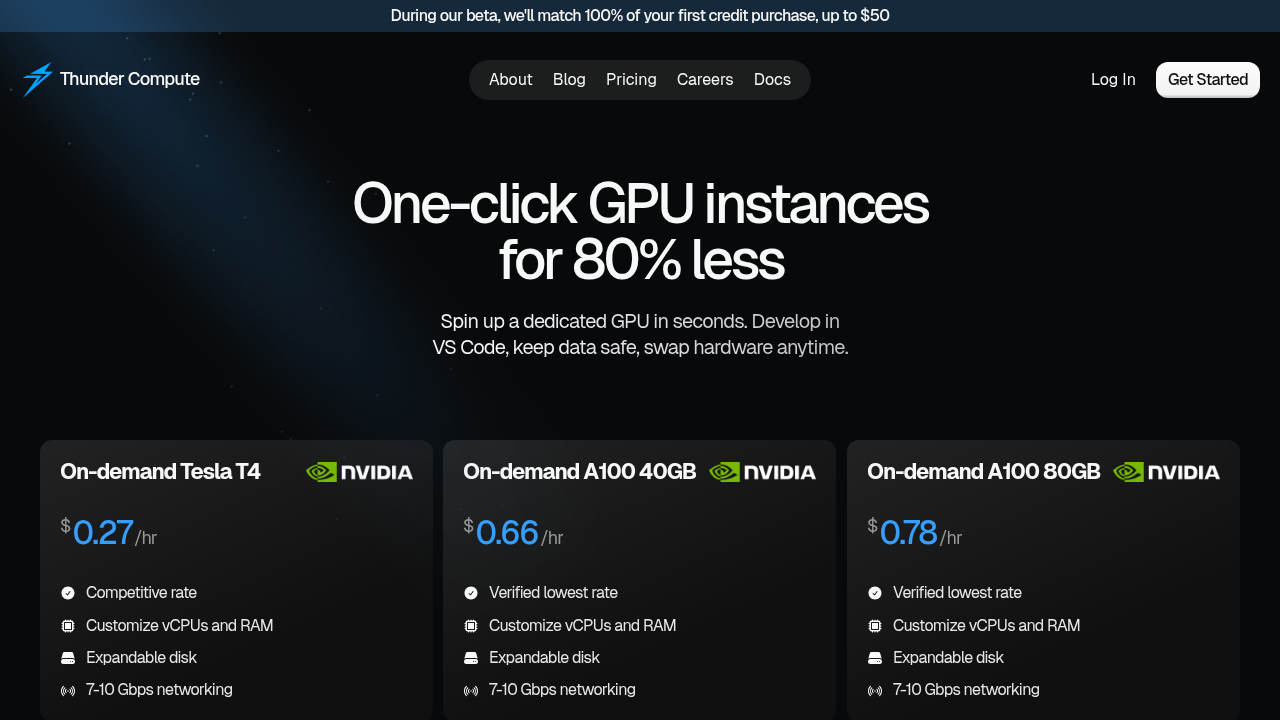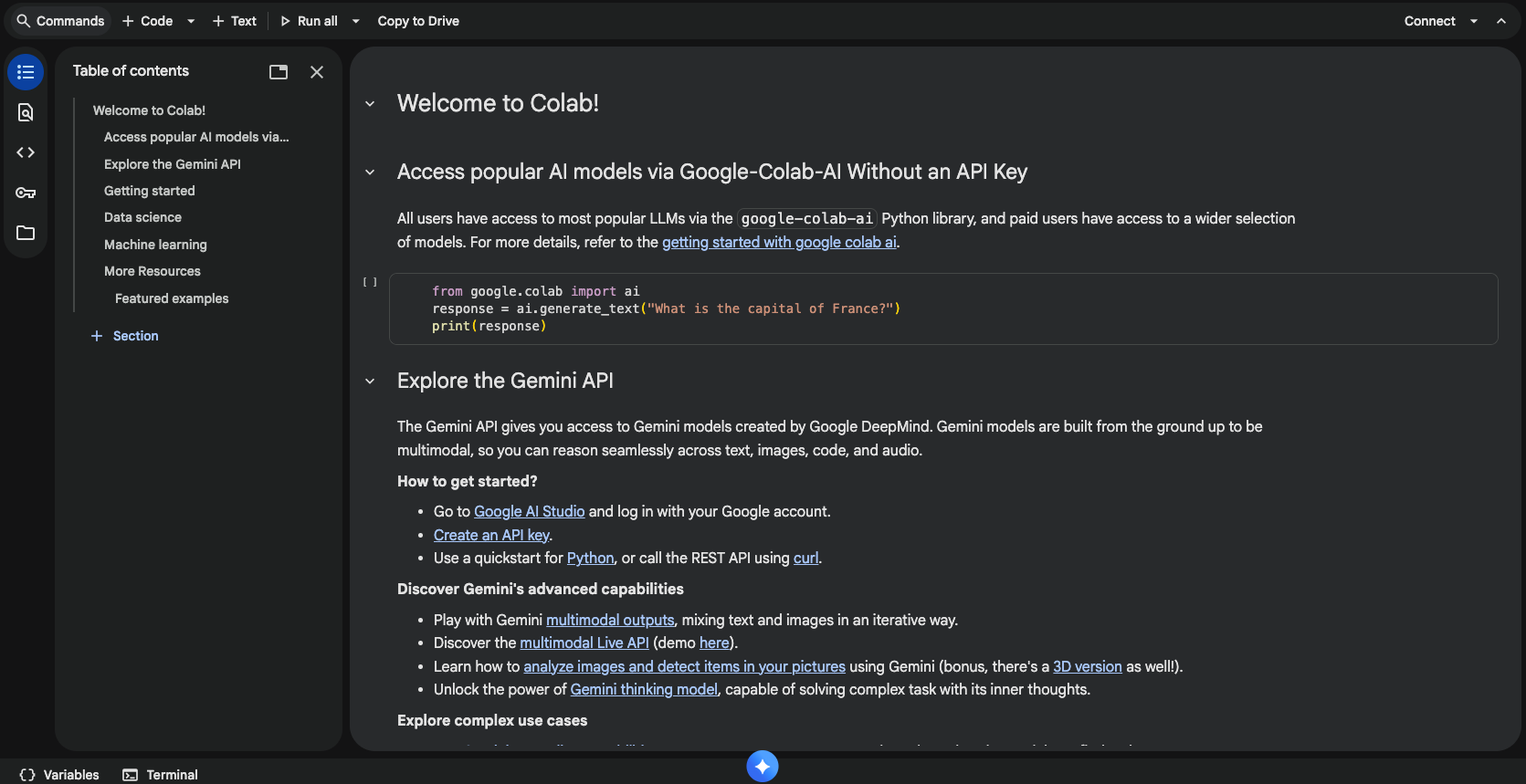Best GPU Clouds for Jupyter Notebook Development (November 2025)

Okay, raise your hand if you've been here: you're ready to train a model, but your CPU is crawling through epochs at a snail's pace. We've all been there which is why interactive computing with GPU clouds is so amazing. It gives you access to professional-grade hardware without the upfront cost of buying your own GPUs. The real question is which provider offers the best balance of price, performance, and simplicity for your Jupyter workflow.
TLDR:
GPU clouds let you rent powerful processors by the hour for Jupyter notebooks, speeding up ML tasks 10-100x vs CPUs.
Pricing varies widely: A100-80GB costs $0.78/hr on some platforms vs $8+/hr on others for similar hardware.
Persistent storage and one-click setup separate production-ready services from session-based tools.
Thunder Compute offers A100s at $0.78/hr with native VS Code integration and automatic environment persistence.
What are GPU clouds for Jupyter notebook development?
GPU clouds for Jupyter notebook development give you instant access to powerful computing hardware through familiar notebook interfaces. Instead of buying expensive GPUs or relying on your laptop's limited resources, you can rent high-performance processors by the hour and run them directly from your browser or development environment.
These services are built for data scientists and machine learning engineers who need serious computing power for training models, analyzing large datasets, or running inference workloads. You get the interactive, cell-by-cell execution style of Jupyter notebooks, but with GPU acceleration that can speed up computations by 10x to 100x compared to CPUs.
How we ranked GPU cloud services
We tested each provider against criteria that matter for notebook workflows:
Pricing ranked first because compute costs accumulate quickly during multi-hour training runs or extended experimentation sessions.
Deployment speed determined how fast you move from signup to executing code. Top services launch notebooks in under 60 seconds, while others require manual SSH key configuration, CUDA driver setup, or storage volume mounting.
Persistent storage was non-negotiable. Providers that treat storage as optional or charge separately ranked below those with built-in persistence.
GPU availability focused on current-generation hardware access like A100s and H100s versus outdated options.
We also weighted developer features like VS Code integration and the ability to pause instances without environment loss, since both reduce friction and costs during development.
Best Overall GPU Cloud: Thunder Compute

Thunder Compute offers GPU cloud instances designed for interactive development workflows. Each instance launches in seconds with dedicated GPUs (1 to 4 per server) and includes native VS Code integration,
Thunder Compute pricing starts at $0.78 per hour for A100-80GB GPUs, roughly 80% less than traditional cloud providers. You can swap GPU types on existing instances without rebuilding your environment, switching from a T4 to an H100 in one click while preserving all installed packages and data.
RunPod

RunPod operates a GPU marketplace with per-second billing across 32 GPU models. Pricing starts at $0.34 per hour for RTX 4090s and reaches $1.99 per hour for H100s. Key features include:
Per-second billing with instant pod deployment through container-based instances
Community and secure cloud tiers with different reliability levels
Pre-built templates for common frameworks, though Jupyter requires separate configuration
GPU options ranging from consumer RTX cards to H100s
The downsides? The containerized approach requires Docker knowledge. Storage persistence costs extra through network volumes, and Jupyter isn't bundled by default. This creates more setup friction than services with integrated notebook environments.
The bottom line: RunPod suits users comfortable with containers but needs more technical configuration than turnkey solutions.
Lambda Labs

Lambda Labs offers GPU cloud infrastructure with pre-configured deep learning environments. Each instance includes Lambda Stack, which bundles popular frameworks and CUDA drivers. Users can launch Jupyter Notebook sessions directly from the dashboard in seconds. Key features include:
Lambda Stack comes pre-installed with deep learning frameworks and dependencies
Direct Jupyter notebook access through the web interface without manual setup
SSH and web terminal options for command-line workflows
Configurations optimized for training and inference workloads
The downsides? The service costs more than specialized GPU providers and lacks pause/resume capabilities for cost control.
The bottom line: Lambda Labs works best for teams that value quick setup and enterprise support over budget optimization.
Google Colab

Google Colab provides free and paid cloud-based Jupyter notebook environments integrated with Google Drive storage. The free tier offers limited GPU access, while paid subscriptions (Pro and Pro+) unlock longer runtimes and better hardware.
Colab has several downsides. The core limitation is session persistence. Notebook environments terminate after inactivity, forcing you to re-upload files and reinstall packages each time. Even with Colab Pro, extended training runs require purchasing additional compute units, and memory limits cause frequent out-of-memory errors during model fine-tuning.
The bottom line: Colab suits casual experimentation and learning but lacks the persistence and reliability needed for serious development work.
Vast.ai

Vast.ai operates a decentralized marketplace where individual GPU owners rent their hardware to users needing compute. This peer-to-peer model creates pricing as low as $0.20 per hour for RTX 3090s through competitive bidding. Core features include:
Peer-to-peer GPU marketplace with spot pricing where you bid on community-provided resources
Jupyter notebook support through Docker container deployments, though setup requires manual configuration
Wide GPU selection from different hardware hosts, with availability fluctuating based on what's online
The downsides? Reliablity. Instances run on community hardware with varying uptime guarantees, and you'll need to copy data between sessions since persistence depends on individual host policies.
The bottom line: This is best for cost-sensitive projects where you can tolerate occasional interruptions.
Paperspace Gradient

Paperspace Gradient offers GPU-powered notebook environments with team collaboration features. The DigitalOcean-owned service targets teams needing shared workspace capabilities alongside compute resources. Core features:
The service includes a free tier with limited GPU quotas, project management tools, and persistent storage.
Integration with common ML frameworks comes pre-configured, and sharing notebooks across team members works through built-in collaboration features.
The downsides? Testing revealed frequent interface glitches, session instability, and workflow interruptions that made basic notebook tasks frustrating. Code that runs reliably elsewhere encountered unexplained failures and UI freezes.
The bottom line: Gradient might appeal if team collaboration outweighs everything else, but the poor user experience makes it difficult to recommend for production work.
Feature Comparison Table of GPU Cloud Services
Pricing varies between providers, with Thunder Compute offering lower hourly rates for enterprise-grade GPUs. Native VS Code integration remains rare among GPU clouds, though most services support Jupyter. Persistent storage and setup complexity separate dedicated GPU clouds from session-based notebook services.
Why Thunder Compute is the best GPU cloud for Jupyter development
94% of data and AI leaders report AI interest is driving greater focus on data work, making accessible GPU compute critical. Thunder Compute directly supports this need with affordable instances ready for notebook development with zero configuration. A100 instances, for example, start at $0.78 per hour with full environment control. While competitors treat Jupyter as an add-on or require Docker setup, our instances come preconfigured for immediate use.
The native VS Code integration lets you edit code, run cells, and manage experiments without switching tools. Work persists automatically between sessions. Pausing instances preserves installed packages and checkpoint files.
FAQ
How do I access Jupyter notebooks on a GPU cloud instance?
Most GPU cloud services provide direct browser access to Jupyter through their dashboard, while others require SSH connection and manual setup. Thunder Compute instances come with Jupyter pre-installed and accessible immediately after launch, with no configuration needed.
What's the difference between persistent and ephemeral storage for notebook work?
Persistent storage keeps your notebooks, datasets, and installed packages intact when you stop an instance, letting you resume exactly where you left off. Ephemeral storage deletes everything when sessions end, forcing you to re-upload data and reinstall dependencies each time.
When should I choose a dedicated GPU instance over a shared notebook service?
Switch to dedicated instances when you're running training jobs longer than 2-3 hours, working with datasets over 10GB, or need specific package versions that shared services don't support. Dedicated instances also make sense if you're spending more than $50/month on shared notebook subscriptions.
Can I run multiple Jupyter notebooks simultaneously on one GPU instance?
Yes, you can run multiple notebooks on a single GPU instance, and they'll share the available GPU memory. Just monitor your memory usage since running too many compute-intensive notebooks simultaneously can cause out-of-memory errors.
Why do GPU cloud prices vary so much between providers?
Pricing differences reflect hardware quality, reliability guarantees, and included features. Lower-cost providers may use community hardware with variable uptime, while higher-priced services include persistent storage, pre-installed frameworks, and enterprise support in their base rates.
Final thoughts on GPU clouds for Python notebook workflows
Finding the right Python notebook GPU service comes down to what friction you're willing to tolerate. Some providers make you rebuild environments every session, while others preserve your work automatically. You'll know pretty quickly which approach fits your development style. Pick something that respects your time and keeps compute costs down.